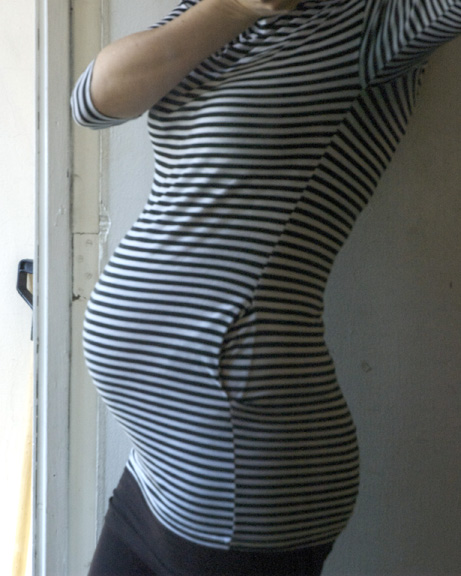He arrived three months ago today, and I suppose I should tell you all about it. But until then, here’s a recording of Finnegan Jay Bartoo and I having a conversation.
Nature's Gate
Poor BiB. I thought that when May arrived, I’d have more time to blog, but it turned out to be the opposite. So here I am playing catch-up as always.
Dr. Awesome and I took a childbirthing class for the last five weeks through Realbirth. Like most such classes, it’s oriented to natural childbirth, but it’s more open to what are called “interventionsâ€â€”such as epidurals—than other similar groups (like Lamaze or Bradley). While it stresses that women have for millennia given birth without such interventions, it also acknowledges that many women today are going to choose them, and screw what grandma went through back in the village. Because I’ve been on the fence about how I wanted labor to go down, it seemed like a nice compromise.
The class was held at a yoga studio near the Smith-9th St. subway station in Brooklyn. Located beneath the elevated station near a scrap-metal recycling center and next to the toxic Gowanus Canal, the area is about as old-school industrial Brooklyn as you can get. And a yoga studio in this environment is about as gentrified as you can get. Well, maybe you could top it with a Montessori school or vegan café.
Anyway.
Before the first class, we the Knocked Up queue for the loo while our menfolk wander around in their socks looking vulnerable, though they make game attempts to seem at ease. They know they are in a realm where they are, paradoxically, both secondary and essential players. After my turn, as I’m washing up I notice the brand of hand soap. It’s called Nature’s Gate.
As we settle into our floor seats—each a minor ziggurat of mats, pillows and folded blankets—I tell Dr. Awesome about the soap: “I got your nature’s gate right here, buddy!â€
At least I refrain from pointing to my crotch.
There are seven couples, and we are quite conventional: all heterosexual, all married. Our instructor, Shara, is also a doula, which is a childbirth coach focused on the mother. Her props include illustrations of the growing womb (which makes me seriously grateful to my horribly squished digestive system for still operating pretty damned well); terrifying yet cartoonish charts laying out the three stages of labor; a Caucasian baby doll whose bald head is more Mediterranean toned from all the handling it’s received; and a soft, plush, anatomically correct model of the female pelvis, which she bends and squeezes like defrosting bread dough to show us the flexibility the pelvic bones have during pregnancy and labor.
What makes me immediately like Shara is what she does with this pelvis when she’s not using it: she casually puts her arm through the birth canal and hangs it from the crook of her elbow.
The first class is devoted to the stages of labor. We learn all sorts of practical facts, and some fun trivia too. A few weeks before labor, the baby’s head drops into the mother’s pelvis in a process called engagement. All I can picture is TNG‘s Jean-Luc Picard: “Engage!†Labor begins when a hormone excreted by the baby’s lungs changes the mother’s hormonal balance. Only 10 percent of births are actually accompanied by the water breaking; most “amniotic membrane rupture†is done by a doctor or midwife with a hooked-end rod. One of the criteria for the Dalai Lama is that his mother’s water must have broken naturally, with the classic movie gush. (Who knew?) Contractions hurt because they pull the cervix up and open, and the pain can range from menstrual-like cramping to a “hula hoop of pain†encircling the body. Oxytocin, the “love hormone,†is produced at only three moments in life: after orgasm, in the mother during breastfeeding, and toward the end of labor, when the baby crowns. Finally, the most awful phrase in all of childbirth—perhaps in all of life—is “mucus plug.†Like a wax seal on a bottle of wine but infinitely less pleasant to break, the mucus plug seals the cervix to prevent infection. It can break at any time up to a few weeks before labor begins, often leaving a quarter-size, pink-tinged, egg yolk-like blob in the toilet.
Blech.
I don’t know if Shara was an actor in the past, but she’s comfortable role-playing a laboring woman. “Dads, these are some of the behaviors you can expect to see from Mom,†she says. Her first depiction is the first stage of labor, which can last for 4 to 24 hours—or more. But, who knew (again), contractions are usually mild and last only 15-45 seconds, and are followed by up to 20 minutes of rest. She puts her hands on the small of her back and paces slowly around the room. “Okay, I think this is it,†she says. “I think this is really happening. But I’m okay.†She tells us about various coping techniques: walking, leaning against a wall, sitting on a physioball, listening to music, hanging out with a good friend, having something to eat or a glass of wine, getting a massage from Dad.
Okay, I think. That’s not so bad. Food. Friends. Wine. Massage. I can do that. It’s like the perfect Saturday! I can do this!
It’s when she depicts the end of the first stage, when the contractions intensify and come more frequently, that I start to sweat it. Bending over to place her hands on a physioball and swaying back and forth, she says, “This is where you might use other coping techniques like controlled breathing or vocalization.â€
“Vocalization†sounds so cool and removed, so anthropological. But what she means by vocalization is far more base: the uncontrollable noises emitted by a creature in distress. “Ohhhhhhhh, ahhhhhh, ugghhhhhh,†she moans and groans so realistically that every one of my animal senses go on high alert. These are the sounds of a being in pain, in trouble, in fear, and I am an utter mammal in response. I want to thump my foot like a rabbit signaling the warren, raise up on my haunches like a startled meerkat, screech like a monkey warning the others that an eagle is circling above. I would flee but I’m too paralyzed by the intensity of my reaction. I’m not alone. The room is utterly still. No one, it seems, even breathes.
Shara breaks out of the role-playing easily and says god knows what. My heart is racing. I can’t hear her. Dear lord. If someone else’s fake labor can so purely freak me out, what the hell is my own real labor going to do to me?
Transition is, as the name suggests, the bridge between the first and second stages of labor; it is then that the cervix dilates to 10 cm, the magic number after which pushing can start. On Shara’s chart, the contractions of transition are depicted as angry, red, jagged peaks coming in quick succession, with little time for rest; the cartoon face to the right of the illustration, which is supposed to show you how the average laboring woman feels during this stage, is twisted in pain and misery. Her skin is red and sweaty. It is seriously not helpful.
Transition is often considered the most difficult part of labor. It is also the shortest, which makes sense, because otherwise we as a species may not have made it. I mean, goddamn it! How is any of this practical? Why is does it have to be so painful? Intelligent design, my ass. If your Sky Dad (’cause He sure ain’t mine) thought this was the best way for humans to reproduce, He really isn’t too bright.
The second stage of labor is when a woman actually pushes, and most report that this stage is better by far than transition, because there is a direction (down) a point (baby out) and some control (said pushing). It is then that a woman feels an intense urge to move the kid along.
Shara forgoes the role-playing and leaves it to the birthing video to show us what this looks like. As soon as the film begins, I too feel the urge to move, but I can’t decide whether it’s to be closer to or farther from the screen. I’ve seen labor films before, but can’t remember in what context. Tenth-grade health class? A National Geographic documentary? Some self-punishing PBS night?
We see three births, two natural and one with an epidural. Ohhhh. Now I want to do some moaning myself. Because it’s immediately clear that the baby storms Nature’s Gate like a Vandal sacking Rome. Because when the baby crowns–meaning you can see the crown of its head–the vernix-slimy hairy skull presses against the so so so so so so so so so small opening with an unstoppable persistence, a demand to be born that will not be denied. Such will and force from so small a being stuns me. I want to burst into tears.
“Babies come out. Babies come out,†Shara had told us earlier in class, mantra-like. “All over the world, every day, babies come out.â€
Every time the baby comes out, I’m completely overwhelmed. It’s only the presence of the others that keeps me from breaking into howling sobs. It’s not fear, or at least not entirely. It’s not amazement, or at least not entirely. It’s a confusing stew of heightened emotion and sheer physical response that has me around the bend. When each mother pulls her purple, wiggling, crying child to her chest with unadulterated relief and joy, I can barely contain myself. I gulp to try to loosen my tightened throat. I simply can’t stop myself from responding so intensely.
No matter how smart I like to pretend I am, no matter how much I try to be rational and thoughtful, when it comes down to it, I’m a complete fucking mammal. I’m one of Pavlov’s dogs.
The third stage of labor is delivering the placenta, which sounds a lot more genteel than it is. Because the placenta, though a remarkable organ that the female body grows only during pregnancy and which nourishes the fetus, is also a horrific blob of blood, veins and various other unknown (to me) viscera. I appreciate its awesomeness and functionality, but Jesus Christ! It is a foul-looking thing. Note to future producers of birthing videos: LESS PLACENTA, PLEASE.
In the darkness after the video ends, I try to wipe away the tears streaming down my face before anyone can see them. “Watch your eyes,†Shara says before turning the lights on. This gives me an excuse to keep my eyes closed, hoping the tears will be reabsorbed, that no one will be able to tell I kind of became a fucking mess right there. I’m not sure why it’s necessary to hide it, but it is. Dr. Awesome has long described me as a quarter-inch of steel covering pure butter. Maybe that’s why.
After class we go to Jakewalk, a bar on Smith Street that serves some 40 cheeses and meats, along with a huge selection of international beers and wines. At this point 33 weeks old, The Kid isn’t storming Nature’s Gate anytime soon, insh’allah. But just in case he’s getting any funny ideas after all those videos, I have a really expensive glass of red wine with the cheese and meat platter—a makeshift nepenthe for me and The Kid. By morning, we’ll both forget that babies come out, babies come out, that all over the world, every day, babies come out.
Because I, for one, am not ready.
XXX! Naked Bump Pix
O.k., these images aren’t exactly scandalous, but I’m not averse to using the lurid to lure you. (Also, I’m sure there are pregnancy porn sites out there, but I’m not actually going to Google to verify. If you do, please spare me—don’t share.)
For weeks now, even through clothing I’ve been able to see The Kid vigorously shifting around in my belly—so many body parts move at once that it kind of looks like a snarl of snakes—but I prefer to watch the action on the bare skin. It’s just so freaking amazing. So yesterday, during The Kid’s typical late-afternoon bump and shimmy, I lifted up my shirt. It was then that Dr. Awesome and I noticed the excellent light coming in through the kitchen windows.
The profile:
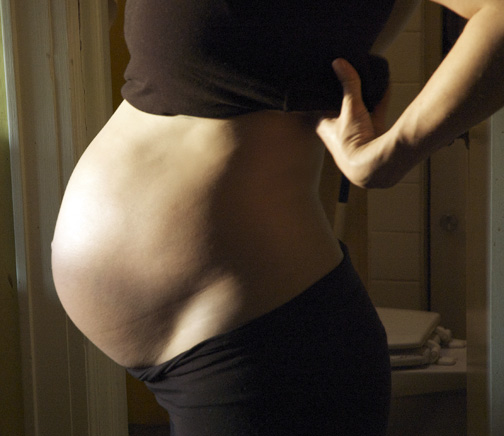
The angled view:
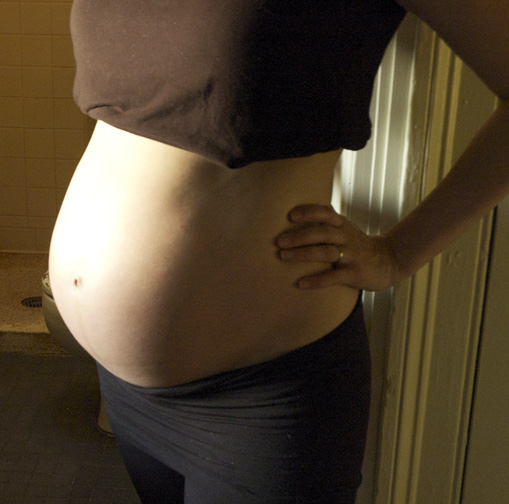
And the frontal:
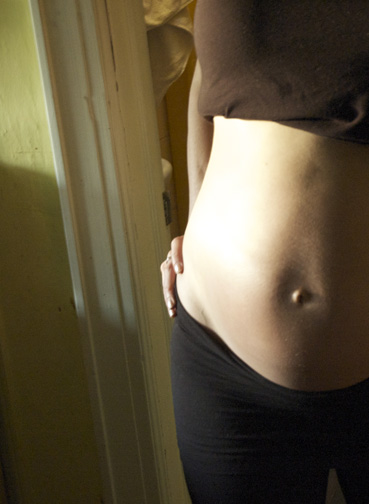
Six more weeks to go. How much bigger will we (The Kid, the bump, me) get?
Soon I’ll actually write here again. But not tonight.
The Corkboard of Rage: What Would You Write?
One thing I neglected to mention in Are You Woman Enough? is that the women I’ve spoken to (or read about) who chose natural childbirth did so for reasons I understand. Most cite a desire to be fully present, to experience every moment no matter how difficult, and to complete labor with not only a newborn child but a profound sense of accomplishment.
“Maybe I’m a masochist,” said SK, a writer and long-distance runner (two self-torturing endeavors, so there’s your evidence). She said she hadn’t wanted to be dulled during the experience, and that she had a purist streak. While I’m far from a purist—it’s the mutts of existence that compel me—I understand not wanting to miss a thing.
But even those most committed to natural childbirth need some encouragement. SK told me about getting to a point during the labor of her second child when she was so overwhelmed by pain and exhaustion that she was considering asking for a C-section. Forget the epidural, she thought: get this kid out of me now.
Her husband gave her a great pep talk urging her to hang on a little longer, she said. He told her, “This baby has to be delivered one way or another, and you are the only one who can do it. You have to go through this experience.”
And that got her through the roughest part. Like her first, her second daughter was born au naturel.
“It’s good that you reacted that way, because there was always another option,” I said. “Which was to say, ‘You have no fucking idea what you’re talking about, so shut the hell up.'”
Which is probably what I would say. Maybe that’s why I reacted so strongly to the idea of a Corkboard of Motivation. I became aware of this innovation in the natural childbirthing room courtesy of BiologyLady, a science teacher and my best friend from childhood, whose sister-in-law is due in a few weeks. BiologyLady’s brother called her last week asking her to come up with some motivational phrase; he would write it on a slip of paper and pin it to a corkboard that would be placed in his wife’s labor room. Then, whenever his wife was feeling like natural childbirth was too much, that she couldn’t get through it, she could look to the corkboard for supportive messages from family and friends.
BiologyLady was fretting about what to write. “I’m no good at these things!” she said. “That’s just not who I am. I mean, even with a birthday card I don’t write anything. Just ‘Love, BiologyLady.’ And what am I supposed to say? ‘Keep pushing’?”
I suggested she skip over the labor and focus on the results: “Maybe something like, ’24 hours from now you’ll be holding your newborn baby’.”
That seemed reasonable to her, so we dispatched with the advice and starting wondering what the fuck was up with this Corkboard of Motivation. BiologyLady has a 3-year-old daughter herself, and happily gave birth with the help of an epidural, thankyouverymuch. “I know I have only my experience to go on, but she’s not going to be looking at a freaking corkboard! She’s kind of going to be occupied.”
“If it were me, I can only imagine it being a Corkboard of Rage,” I said. I tried to picture it. It would be propped up on the windowsill, its mealy-brown surface fluttering with scraps of paper. I imagined the increasing pain and exhaustion, and trying to take heart from those chipper messages written by people having beers or answering email or sleeping—doing anything but being split open. I envisioned eyeing it with twin beams of hate, throwing darts at considered messages of encouragement, lodging knives in notes expressing the beauty and wonder of birth. I imagined one long howl of fuuuuuck youuuu.
So maybe it could serve some kind of purpose: as a focal point for the pain, or apparently my rage over the pain. It’s a better option than throwing stuff at Dr. Awesome, I suppose—though I am in no way ruling that out.
So here’s my question. What would you write on my Corkboard of Rage? And skip the sweet advice. What’s the very last thing you think I’d want to hear?
More Bun for Your Buck: Pix at Nearly Eight Months
Filler alert! A trio of somewhat blurry pix of the bun: full-length, midground, and dear lord.
Welcome to the bun!
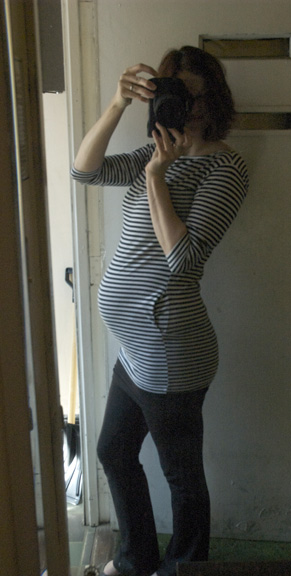
Let’s look a bit closer at its funny roundness
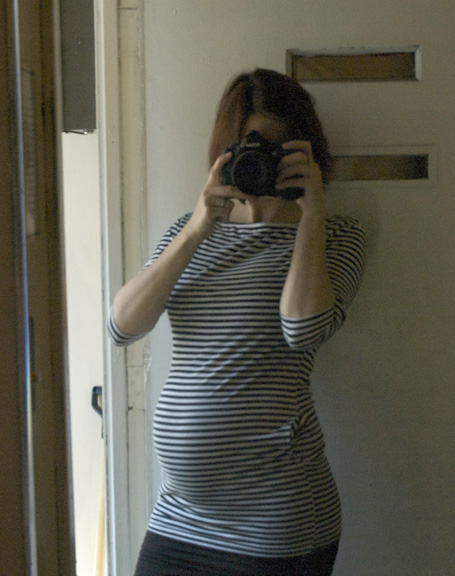
This thing is like a bomb shelter, yo. I just hope it doesn’t house a crazy
